Friday, January 31st, 2020.
In this Daily: How Surf Breaks Form
A surf break requires a number of key conditions to form, requiring just the right underwater topography, offshore swell direction, and wind at the right times to culminate in a clean and surfable wave. These conditions can be rare, which is what makes Guanacaste and its wide variety of surf breaks into one of the world’s most well-known destinations for surfing.
 The presence of prime conditions for surfing make Guanacaste an international destination for the sport
The presence of prime conditions for surfing make Guanacaste an international destination for the sport
The Key Elements of a Surf Break
There are three key elements that factor into the creation of a surfable wave: a strong enough swell, proper underwater topography, and proper wind/wind direction.
Swell
Swells are large scale waves that are no longer being directly generated by wind. Usually resulting as a factor of large storms or winds offshore, swells are the fundamental building block of a surfable wave.
 The power and direction of the swell ultimately determine the character of a surf break at any particular day | PC: Commons
The power and direction of the swell ultimately determine the character of a surf break at any particular day | PC: Commons
For a surf break to occur, the swell that reaches it has to be large enough to manifest into a wave. Guanacaste is right on the Pacific Ocean, so it catches the big swells from the storms and winds out in the Pacific Ocean. This is also why Hawaii and Indonesia are known for such massive surf breaks, since they are surrounded on all directions by the open ocean.
It’s for this reason that beaches on lakes and small gulfs rarely develop surfable waves. These beaches are either too far from the large swells of offshore storms, or rather too landlocked for any localized offshore storms to develop large enough to generate meaningful swell.
Underwater Topography
Once a swell has developed, it typically needs to encounter some form of underwater topography to ‘break’, or rise up far enough out of the water that it can propel a surfer forward, rather than simply lifting them up and down. In certain places offshore, swells can break on themselves, but these waves are so large that only the most aggressive big wave surfers like Laird Hamilton surf them.
For surf breaks close to the shore, these macro-waves collide against some form of underwater topography, usually the shore. Unable to continue moving directly forward, the water is abruptly pushed up and manifests as a breaking wave. However, this is just one aspect of a surfable break.
Waves generate radially from wind and storms action out in the ocean, but by the time they hit the shore swells have spread far enough from their genesis point as to be functionally flat. When breaking on a flat shoreline, waves will simply raise up as one and ‘close out’, crashing down as one and leaving little room for the surfer to ride the wave. On a smaller scale, this is what happens with the waves in Las Catalinas, which form ideally for body surfing.
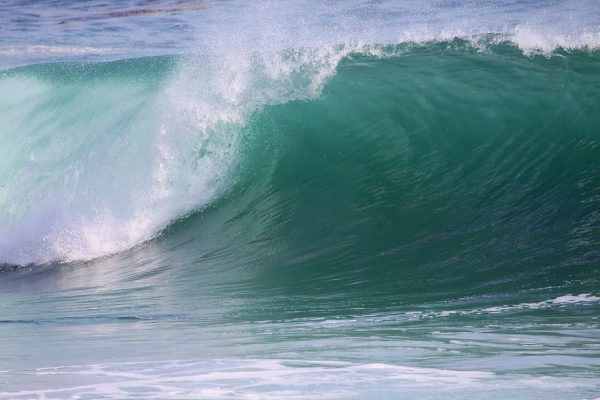 The ideal wave for surfing is one that 'peels', allowing the surfer to maintain speed right at the break point, where the wave has the most power, and ride along the wave | PC: Commons
The ideal wave for surfing is one that 'peels', allowing the surfer to maintain speed right at the break point, where the wave has the most power, and ride along the wave | PC: Commons
For a wave to peel, in which a surfer can ride along the edge of a breaking wave, there must be a distinct underwater feature that forces part of the swell to rise up and break. This action then causes a ripple effect down the swell that allows a surfer to ride the break along the shore, rather than directly towards it. This topography can be many things: a sand bar naturally occuring on the bottom or caused by a river or estuary, it can be a pier or a naturally occurring point, it can be a rock or coral reef. As long as the wave breaks slanted, there is a good chance it can be surfed.
Wind
Swells are the result of macro-scale wave action, and are no longer being created by the wind. However, the wind causes wave action within the break, which can either smooth out a break or make a break “dirty.” For example, the presence of smaller waves on a beach can disrupt the bigger waves, making the break choppy. It can also press waves from behind, closing them out too quickly, or with a strong offshore direction not allow waves to form.
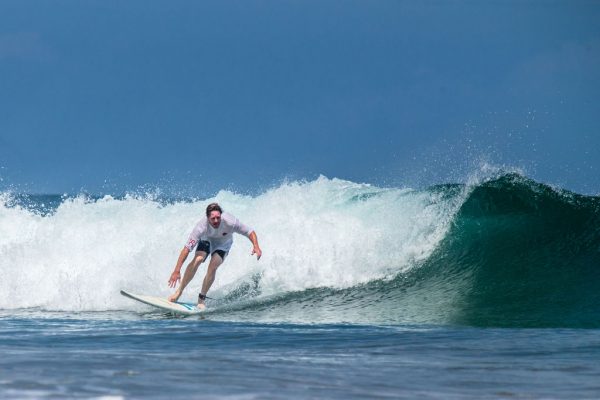
However, favorable winds from offshore can help a great deal, helping ‘hold up’ a wave and make it break smoother and for a longer period of time.
The Types of Breaks
There are four main types of surf breaks, bottom breaks or beach breaks, point breaks, reef breaks, and river mouth breaks.
Bottom Breaks
Bottom breaks are the simplest form of a surf break. These breaks result from heavy swell colliding with the upward slope of the sandy bottom at an angle, resulting in a surfable break. On beaches, due to tides, the waves, and the water, the bottom constantly shifts, so exact spots for each break change day to day and hour to hour.
Some examples of famous bottom breaks in Guanacaste are Playa Grande and Witch’s Rock.
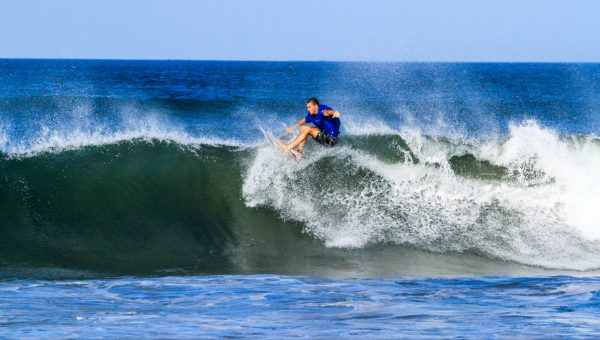 Playa Grande is a break known as a "swell magnet", with a large sweeping shoreline that is surfable at most swell angles and most days of the year. However, this wide variety of potential swells and bottom conditions means that every day at Playa Grande is different from the last
Playa Grande is a break known as a "swell magnet", with a large sweeping shoreline that is surfable at most swell angles and most days of the year. However, this wide variety of potential swells and bottom conditions means that every day at Playa Grande is different from the last
Point Breaks
Point breaks result when a swell hits a landmass or point coming out from the shore, which can either be a natural peninsula or a manmade structure like a pier. The crash of the swell on the point then causes the wave to begin closing out parallel to the beach. These breaks tend to be predictable, with a specific angle of swell and location where they will consistently break.
Playa Flamingo, just down the road from Las Catalinas, is the nearest example of a point break.
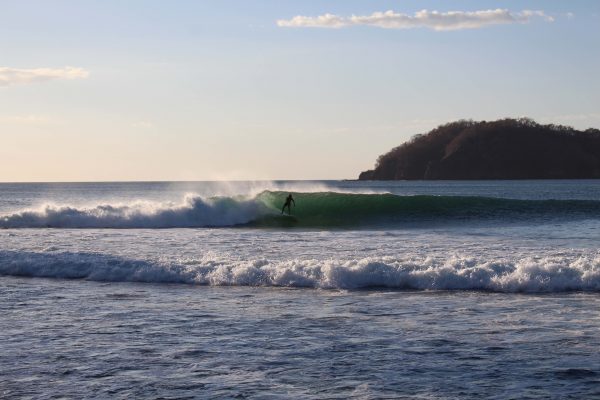 Surfing on Playa Flamingo, a point break that requires a specific swell and swell angle to begin firing, but remains relatively consistent
Surfing on Playa Flamingo, a point break that requires a specific swell and swell angle to begin firing, but remains relatively consistent
Reef Breaks
Reef breaks are a more sudden form of a bottom break, where the swell collides with a coral or rock reef under the water and suddenly crests up. Reef breaks are some of the most powerful breaks in the world thanks to this quick formation, and tend to be the breaks that are used for surfing competitions, but the presence of shallow underwater structures can make these breaks more dangerous for the beginner surfer. A higher thrill for a more experienced rider of the waves.
Playa Avellanas in Guanacaste has a mild reef break (alongside its bottom break and point break), that tends to be one of the more active spots on the beach.
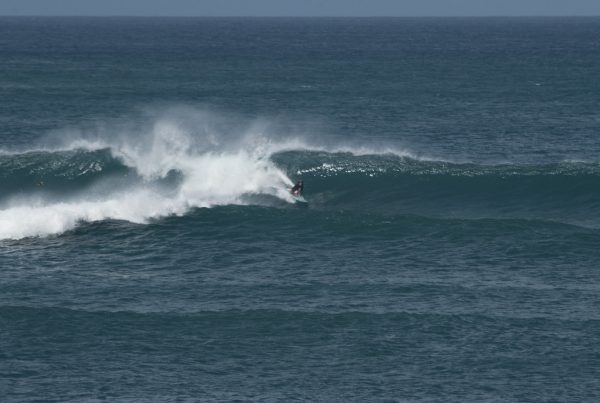 The reef break at Avellanas is one of the larger breaks on the beach
The reef break at Avellanas is one of the larger breaks on the beach
Rivermouth Breaks
The last type of break is a rivermouth break, where the buildup of sediment or sand at a river or estuary creates an underwater structure that shapes the swell into a surfable wave. Rivermouth breaks tend to be a midpoint between point breaks and bottom/reef breaks, more predictable in terms of position, but often with a wider swell angle at which they can be surfed.
Playa Tamarindo’s rivermouth break at the north end of the beach is the nearest rivermouth break, and tends to be some of the biggest and most consistent surfing on the beach when the swell is right.
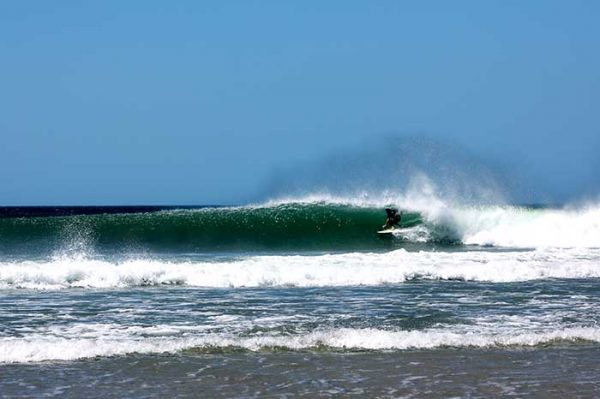 Tamarindo has a number of different surf spots, including a rivermouth break on the north end of the beach. | PC: Commons
Tamarindo has a number of different surf spots, including a rivermouth break on the north end of the beach. | PC: Commons
Make Las Catalinas A Surf Base Camp
Guanacaste is one of the world’s best destinations to surf, and Las Catalinas is located centrally to many different breaks, making Town and excellent surf base camp to learn to surf or surf the region’s biggest waves.
[maxbutton id="1" url="https://cta-redirect.hubspot.com/cta/redirect/4917861/bb90976c-fd33-457a-a285-892e384bad66" text="Visit Las Catalinas" ]